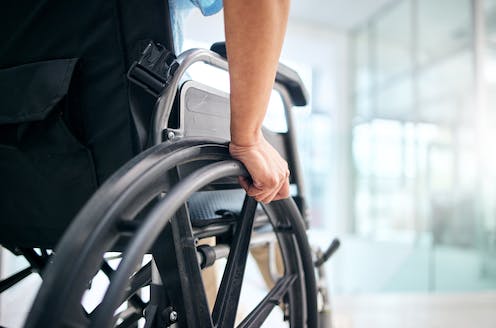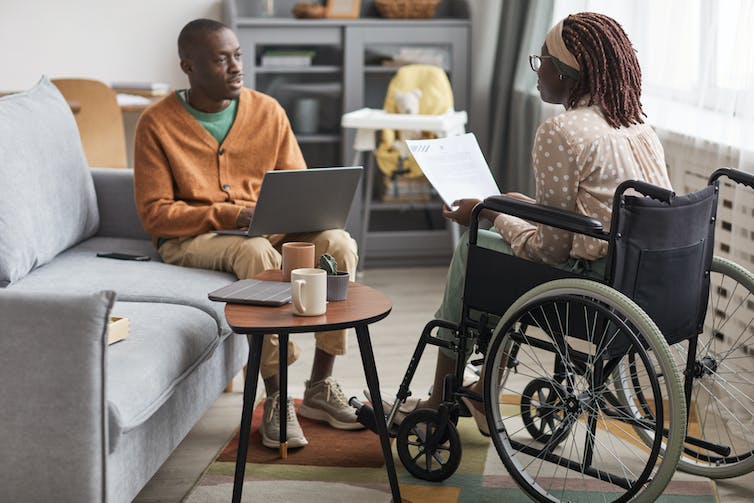
Disability is a common part of the human experience: the United Nations estimates that 16 per cent of the world’s population is disabled, and a 2019 study from the United States found that over half of American adults aged 18 to 34 have at least one chronic illness.
Unfortunately, being disabled can often mean being poor. One recent report from the U.S. found the poverty rate for people with disabilities was just over 25 per cent, whereas the poverty rate for non-disabled people was under 12 per cent. These percentages are very similar in Canada, although the recently passed Canada Disability Benefit may help alleviate this situation.
One reason for this is that people with disabilities can often lack access to good, well-paying work. Many countries have tried to solve this problem by adopting legislation that protects disabled people from employment discrimination and guarantees them reasonable accommodations at work. Despite these laws, people with disabilities around the world still have much lower rates of employment than non-disabled people.
Researchers are trying to understand why these laws have not closed the disability employment gap, and what governments, organizations and individuals can do to fix it.
Table of Contents
The PROUD Project
We are part of a research team called The PROUD Project based at the University of Toronto. The project is focused on understanding how disabled people can beat the odds and find work.
To do this, we interviewed disabled employees, disabled entrepreneurs and managers of disabled workers. For this project, we only included workers with evident physical or sensory disabilities, because they face different challenges than people with invisible disabilities.
We interviewed people in five developed countries: Canada, the U.S., the United Kingdom, France and Belgium. We wanted to see if different laws, cultures and physical environments had an impact on disability and employment. The more than 80 semi-structured interviews we conducted revealed several factors that allowed disabled people to find work.

(Shutterstock)
What we found
Legislation is an important mechanism for supporting disabled workers. In the U.S., many people used the Vocational Rehabilitation program (created by a 1973 law) to establish careers. Meanwhile, France enforces a quota which requires businesses with more than 20 employees to have six per cent of their workers identified as disabled or pay an annual fine.
However, many companies do not meet the quota. In 2021, only 29 per cent of companies met their obligations. Several of our interviewees observed that some companies even explicitly decide to pay the fine instead of hiring disabled people. Yet, having the quota law forces companies to think about disabled workers. While the majority of employers pay the fine for not meeting the quota, many admitted the annual audit makes them think about the issue.
Endurance and persistence were common themes in the interviews — many participants described themselves as “fighters.” Some of them went to dozens of job interviews before finally landing a position.
In addition, having formal and informal support networks were important for interviewees. In the U.S., the Vocational Rehab program can facilitate this through their counsellors. Often, persistence was encouraged by parents, teachers and other mentors. Several participants said their parents had always treated them as “normal,” and expected them to have a “normal” life path, including a career.
Accessible transportation is also essential for a successful career. Many of the participants we spoke to lived within walking or rolling distance from their workplace. Some took accessible public transit, while others had adapted transportation to work.
Designing and implementing accessible public transit systems is an important step that governments must take to ensure people with disabilities can get where they need to go. Without the ability to move around, disabled individuals simply cannot get to work. For example, the Access to Work program in the U.K. pays for disabled workers to take taxis to work. This means that people can financially provide for themselves and their families.
Read more:
How Canada can make better progress on disability inclusion
Reforming government programs
In some countries, disability pensions prevent disabled people from working. Many participants talked about the stress they felt when deciding to take the risk of working and potentially losing their benefits.
Others still received some benefits, but had to be very careful about how much they worked. On the other hand, some participants had independent financial resources that were not subject to restrictive state policies. Governments need to move away from viewing disabled people as burdens and only providing them with subsistence support and move toward facilitating their contribution and participation in communities.
Disabled people also need access to high quality education. In general, disabled people tend to have lower levels of education than the general population. However, the participants we interviewed had higher levels of education than the average in all five countries.
In fact, many disabled workers were overqualified for their current positions. This suggests that disabled people need to have higher levels of education than non-disabled people to get the same job.
They also have to contend with other barriers and preconceptions about their abilities. Fears, misconceptions and prejudices about disabled persons create barriers to professional inclusion.

(Shutterstock)
Supportive workplaces vital
Our project found that it was much easier for disabled people to find work in sectors, industries and companies where employers were aware, supportive and proactive about disability inclusion. For example, employees with disabilities in all five countries tended to work in non-profit or government sectors, where attitudes toward disability may be more positive than in the private sector.
Once again, France was an outlier; private industry employers we spoke to expressed enthusiasm for hiring individuals with disabilities. They recognized the contributions made by disabled employees and expressed a desire to hire more disabled workers.
Read more:
Why it makes good business sense to hire people with disabilities
Several French managers wanted to educate non-disabled workers and supervisors about the benefits of including their disabled colleagues. Others argued that social stigma means that some employees who qualify do not want to receive an official designation of disability.
However, it is important to acknowledge that, even for disabled people who had managed to find work, there were still significant problems. Some experienced little or no career development, staying in the same roles for which they had been originally hired. Others could only find work in disability-related positions, even if their education, training and skills were tailored to other industries.
Disabled people are capable, flexible, adaptive and creative. Governments and private companies must do more to include disabled people in the workforce. By not doing so, communities will lose out on the contributions talented people could make.
![]()
Chloe G K Atkins receives funding from the Social Sciences and Humanities Research Council of Canada and TechNation.
Isabelle Avakumovic-Pointon receives funding from the Social Sciences and Humanities Research Council of Canada and TechNation.























